|
|
|
Sort Order |
|
|
|
Items / Page
|
|
|
|
|
|
|
| Srl | Item |
| 1 |
ID:
101966
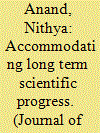

|
|
|
| 2 |
ID:
105121
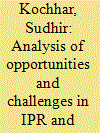

|
|
|
|
|
| Publication |
2011.
|
| Summary/Abstract |
This paper assimilates and contributes to the current state of IPR knowledge and proprietary products in the Indian jurisdiction. The influence of international IPR domain and influx of proprietary foreign technology products on Indian agricultural technology profile vis-à-vis the plight of the national players is discussed, particularly, with respect to patenting in plant biotechnology/transgenics. The factual scenario under the national PPV&FR regime is narrated. This paper also analyses the recent foreign interests in respect of patenting in the areas of animal vaccines and diagnostics vis-à-vis the existing strength of the national system, which needs to be maintained.
|
|
|
|
|
|
|
|
|
|
|
|
|
|
|
|
| 3 |
ID:
096425
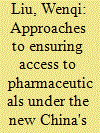

|
|
|
| 4 |
ID:
101203
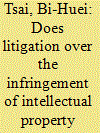

|
|
|
|
|
| Publication |
2010.
|
| Summary/Abstract |
This paper seeks to clarify the relationship between intellectual property right (IPR) infringement lawsuits and innovation by firms through an analysis of data from eighty-seven Taiwanese integrated circuit (IC) manufacturers in the period 2001-2006. The results show that the rapid growth in patent grant is positively related to the occurrence of patent infringement lawsuits, which implies that IPR infringement litigation strengthens firms' incentives to innovate. Patent holders adopt an "aggressive strategy" that makes use of the offensive function of patents to initiate lawsuits against alleged violators. The defendants then adopt a "regressive strategy" by building up "patent walls" to refute the charge and defend themselves. In addition, Taiwanese IC firms are more inclined to develop patents when they are defendants rather thanwhen they are plaintiffs. This suggests that the defensive function of patents has a more profound impact than the offensive function for Taiwanese IC firms. These firms do not possess the core technology needed in IC-relatedmanufacturing processes,and they have in the past applied other firms' technology without obtaining legal licenses. In response to accusations of infringement, Taiwanese IC firms adopt a "regressive strategy," encouraging their employees to develop patents which they then use to refute the charge of IPR infringement.In addition, it is found that stock-based bonuses are a better incentive for encouraging employees to develop patents for their firms.
|
|
|
|
|
|
|
|
|
|
|
|
|
|
|
|
| 5 |
ID:
144972
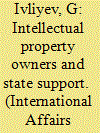

|
|
|
|
|
| Summary/Abstract |
Armen Oganesyan, Editor-in-Chief of International Affairs: Grigory Petrovich, there have been many cases where researchers in different countries, including in Russia, made important discoveries, but they were patented by the Americans. How does this happen?
|
|
|
|
|
|
|
|
|
|
|
|
|
|
|
|
| 6 |
ID:
108001
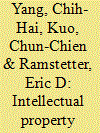

|
|
|
|
|
| Publication |
2011.
|
| Summary/Abstract |
This paper aims to systematically investigate the impacts of strengthening intellectual property rights on patenting in China's high-technology industries and to explore the potential differences in response to patent reform by ownership. Empirical results show that the estimated patent elasticity of R&D is lower than that for OECD countries, indicating relatively low R&D productivity for China's high-technology industries. The direct innovation effect of technology imports is negative, while the absorptive ability embodied in R&D helps in gaining external sources of knowledge, thus contributing to innovations. Specifically, strengthening intellectual property rights can induce more innovations in terms of patents in China's high-technology industries and is particularly relevant to foreign-owned high-technology enterprises.
|
|
|
|
|
|
|
|
|
|
|
|
|
|
|
|
| 7 |
ID:
105129
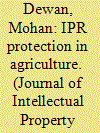

|
|
|
|
|
| Publication |
2011.
|
| Summary/Abstract |
Private rights in living objects have always been controversial. Agriculture provided the first wave in human civilization. Therefore, agriculture including plant breeding and agricultural methods pre-dated any form of IPR protection unlike industry and commerce. Traditionally, IPR was not applied to agriculture. In recent times, this position has changed and increasingly agriculture is seen as an industry that cannot survive without research and development and astute investments. This has made it necessary that IPR in all its forms be extended to agriculture.
|
|
|
|
|
|
|
|
|
|
|
|
|
|
|
|
| 8 |
ID:
172247
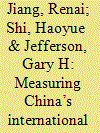

|
|
|
|
|
| Summary/Abstract |
This article compares China’s science and technology advance with the US, Japan, South Korea, the United Kingdom, Germany, and France. Using World Intellectual Property Organization and United States Patent and Trademark Office data for the number and quality of patent grants issued by foreign patent offices, several results stand out. First, within a short period, 2010–2017, China has registered a dramatic surge in granted patents, narrowing the foreign patent count gap with a number of largeOECD economies. However, quality adjustments show less impressive gains for Chinese patenting, particularly concerning semiconductors, where a large decline in quality accompanied thesurge in patenting. The article places China’s patent performance in a broader context, taking into account, the dimensions of population, geography, and time.
|
|
|
|
|
|
|
|
|
|
|
|
|
|
|
|
| 9 |
ID:
021919
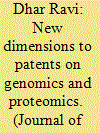

|
|
|
|
|
| Publication |
March 2002.
|
| Description |
119-127
|
|
|
|
|
|
|
|
|
|
|
|
|
|
|
|
| 10 |
ID:
110487
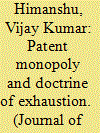

|
|
|
|
|
| Publication |
2011.
|
| Summary/Abstract |
A patent is granted for an invention that is novel, non-obvious, and has an industrial application. The proprietor of the patent grant is able to exploit and control the use of patented matter. Patent as a form of personal property may be assigned, licensed, mortgaged and may devolve by operation of law. The patent exhaustion doctrine, also known as the first sale doctrine, operates to 'exhaust,' or extinguish, the exclusive rights of sale and use as to patented articles sold with the patent owner's authorization. In this background, this article develops the concept of exhaustion and surveys the nature, scope and ambit of the doctrine of patent exhaustion. The relevance of doctrine and right of exclusivity is thoroughly discussed with regard to commercial transactions involving licensing, assignment, sale, disposal or offer of disposal of the patented articles. The article concludes that those conditions which are within the scope of patent monopoly act as limits on the doctrine of exhaustion of right in the sold goods. The exhaustion of right is limited to patented goods, therefore the purchaser has all rights except right to reconstruct. This article while discussing the doctrine from international and national perspective suggests rethinking of the nomenclature of doctrine of exhaustion as contained in Article 6 of the TRIPS Agreement.
|
|
|
|
|
|
|
|
|
|
|
|
|
|
|
|
| 11 |
ID:
143394
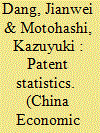

|
|
|
|
|
| Summary/Abstract |
Using a merged dataset of Chinese patent data and industrial survey data, we make a bibliometric analysis of patenting activities of Chinese large and medium-sized enterprises under local patent subsidy programs and test whether patent statistics are a good indicator of innovation in China. Our empirical results show that patent count is correlated with R&D input and financial output, which suggests that patent statistics are meaningful indicators. However, patent subsidy programs increase patent counts more than 30%. We emphasize the necessity of adjustments and provide a novel method of using the number of nouns in claims to quantify the claim scope, thereby overcoming the shortcomings of Chinese patent data that have no citations or lack well-documented patent claim information. We extend prior studies on patent subsidy programs by providing a detailed clarification of policy designs and their impacts and by evaluating policy impacts on both the quantity and quality of patent applications.
|
|
|
|
|
|
|
|
|
|
|
|
|
|
|
|
| 12 |
ID:
021938
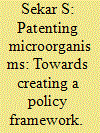

|
|
|
|
|
| Publication |
May 2002.
|
| Description |
211-221
|
|
|
|
|
|
|
|
|
|
|
|
|
|
|
|
| 13 |
ID:
101074
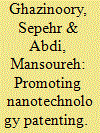

|
|
|
|
|
| Publication |
2010.
|
| Summary/Abstract |
International circumstances, Iran's special context and its legal system have often been blamed for the relative lack of attention on the part of Iranian scientists towards Intellectual Property Rights (IPR). In spite of these odds, however, the Iran Nanotechnology Initiative Council (INIC) launched a programme to overcome existing shortcomings and encourage nanotechnology researchers to protect their inventions in the country and particularly, overseas. The efficiency and effectiveness of this programme are analysed in this paper. In a country without a national IP policy, successful implementation of this programme could pave the way for extending the same mechanism to other technological fields, although it is unlikely that the deficiencies of Iran's national innovation system could be completely resolved by such sectoral policies.
|
|
|
|
|
|
|
|
|
|
|
|
|
|
|
|
| 14 |
ID:
149908


|
|
|
|
|
| Summary/Abstract |
Among the various alternatives available to reduce greenhouse gas (GHG) emissions, carbon capture and storage (CCS) is considered to be a prospective technology that could both improve economic growth and meet GHG emission reduction targets. Despite the importance of CCS, however, studies of technology and demand forecasting for CCS are scarce. This study bridges this gap in the body of knowledge on this topic by forecasting CCS technology and demand based on an integrated model. For technology forecasting, a logistic model and patent network analysis are used to compare the competitiveness of CCS technology for selected countries. For demand forecasting, a competition diffusion model is adopted to consider competition among renewable energies and forecast demand. The results show that the number of patent applications for CCS technology will increase to 16,156 worldwide and to 4,790 in Korea by 2025. We also find that the United States has the most competitive CCS technology followed by Korea and France. Moreover, about 5 million tCO2e of GHG will be reduced by 2040 if CCS technology is adopted in Korea after 2020.
|
|
|
|
|
|
|
|
|
|
|
|
|
|
|
|
| 15 |
ID:
092458
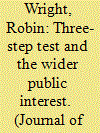

|
|
|
|
|
| Publication |
2009.
|
| Summary/Abstract |
Intellectual property law aims to protect the public interest in two often-contradictory ways: by granting exclusive rights to encourage creativity and by limiting those rights in certain situations for socially beneficial purposes. The Three-Step Test in international intellectual property treaties aims to ensure that limitations and exceptions to intellectual property rights do not inappropriately encroach upon the interests of rights holders. This article examines the interpretation of the Three-Step Test as included in the Agreement on Trade-Related Aspects of Intellectual Property Rights for copyright and patents by two World Trade Organization dispute-resolution panels and by other commentators. It looks at how these interpretations have dealt with the public policy motivations underlying limitations and exceptions to exclusive rights, and considers the ways in which the public policy intentions that underlie decisions by national legislators to adopt the limitations and exceptions to intellectual property rights can be considered in each step of the test. The conclusion reached is that the Three-Step Test contains the potential to allow both aspects of the public interest to be considered as part of an inclusive interpretation.
|
|
|
|
|
|
|
|
|
|
|
|
|
|
|
|
| 16 |
ID:
182745
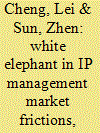

|
|
|
|
|
| Summary/Abstract |
This paper examines the maintenance decisions for intellectual property (IP) that require continuous investment in an uncertain market environment. We propose a microfoundation-based theory that incorporates market friction, market connection and escalation of commitment from the managers. In a dynamic market with frictions, managers with weak market connection need longer time to reach successful transactions, compared to the strongly connected ones. Moreover, escalating behavior could make it harder for the less connected managers to abandon their IP assets even when the embedded value becomes obsolete, which leads to inefficiently longer maintenance and an unforeseen social loss. The model further suggests that removing frictions in the market facilitates transactions and reduces the performance gap between different managers. We provide empirical evidence that is consistent with the theory, using data on patents from individual innovators with different levels of market connection. The study contributes to the discussion on organizational implications of escalation of commitment, and also shed light on the importance of market connection to value capture of small innovative businesses.
|
|
|
|
|
|
|
|
|
|
|
|
|
|
|
|
|
|
|
|
|